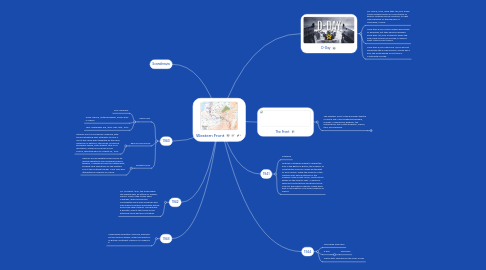
1. D-Day
1.1. On June 6, 1944, more than 160,000 Allied troops landed along a 50-mile stretch of heavily-fortified French coastline, to fight Nazi Germany on the beaches of Normandy, France.
1.2. More than 9,000 Allied Soldiers were killed or wounded, but their sacrifice allowed more than 100,000 Soldiers to begin the slow, hard slog across Europe, to defeat Adolf Hitler’s crack troops.
1.3. More than 5,000 Ships and 13,000 aircraft supported the D-Day invasion, and by day’s end, the Allies gained a foot-hold in Continental Europe.
2. The Front
2.1. The Western Front of the European theatre of World War II encompassed Denmark, Norway, Luxembourg, Belgium, the Netherlands, the United Kingdom, France, Italy, and Germany.
2.1.1. Situational Analysis / Drivers
2.1.1.1. What is driving us to do this?
2.1.1.2. SWOT Analysis
2.1.1.2.1. Strengths
2.1.1.2.2. Weaknesses
2.1.1.2.3. Opportunities
2.1.1.2.4. Threats
2.1.1.3. Customer Findings - What have we learned from customers?
2.1.2. Competitive Analysis
2.1.2.1. Do we have competitors and threats in these target markets with the proposed offerings?
2.1.2.2. What are our competitors doing and how are they positioning?
2.1.2.3. How do we position against each competitor?
2.1.3. Target Customer(s)
2.1.3.1. Buyer Profile
2.1.3.1.1. Title
2.1.3.1.2. Industry
2.1.3.1.3. Geography
2.1.3.1.4. Business Size
2.1.3.2. Influencer Profile
2.1.3.3. User Profile
2.1.3.4. What do customers want and need?
2.1.3.5. What business problems do each of these customers have?
2.1.4. Customer Segmentation
2.1.4.1. Which customers or sets of customers do we sell to?
2.1.4.2. What are the target market segments that we want to go after?
2.1.4.3. What are the distinct problems for each segment of the market?
2.1.5. Total Available Market
2.1.5.1. New Prospects
2.1.5.1.1. How much of each target segment have we penetrated?
2.1.5.1.2. How much opportunity is available in each target segment?
2.1.5.2. Existing Customers
2.1.5.2.1. Can we up-sell existing customers?
3. Scandinavia
4. 1941
4.1. Interlude
4.2. With the Luftwaffe unable to defeat the RAF in the Battle of Britain, the invasion of Great Britain could no longer be thought of as an option. While the majority of the German army was mustered for the invasion of the Soviet Union, construction began on the Atlantic Wall – a series of defensive fortifications along the French coast of the English Channel. These were built in anticipation of an Allied invasion of France.
5. 1942
5.1. On 19 August 1942, the Allies began the Dieppe Raid, an attack on Dieppe, France. Most of the troops were Canadian, with some British contingents and a small American and Free French presence along with British and Polish naval support. The raid was a disaster, almost two-thirds of the attacking force became casualties.
6. 1940
6.1. Phony War
6.1.1. Axis: Germany
6.1.2. Allies: France, United Kingdom, Polish army in france
6.1.3. Year: September 3rd, 1939- May 10th, 1940
6.2. Race Across France
6.2.1. German front in Normandy collapsed, with troops retreating east. Attempts to form a line at the Seine were thwarted by the rapid advances of Patton's Third Army. Moving at breakneck speed, often against little or no resistance, Allied forces raced across France, liberating Paris on August 25, 1944.
6.3. Defeat France
6.3.1. German forces defeated Allied forces by mobile operations and conquered France, Belgium, Luxembourg and the Netherlands, bringing land operations on the Western Front. Italy entered the war June 1940 and attempted an invasion of France.
7. 1943
7.1. Codenamed Operation Overlord, planning for the invasion began, under the direction of British Lieutenant-General Sir Frederick E.
8. 1944
8.1. Normandy allies won
8.2. D Day
8.2.1. allies won
